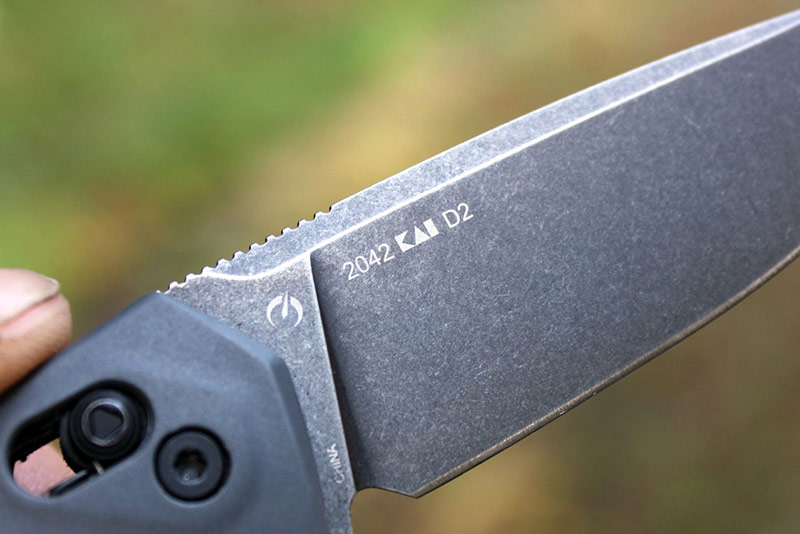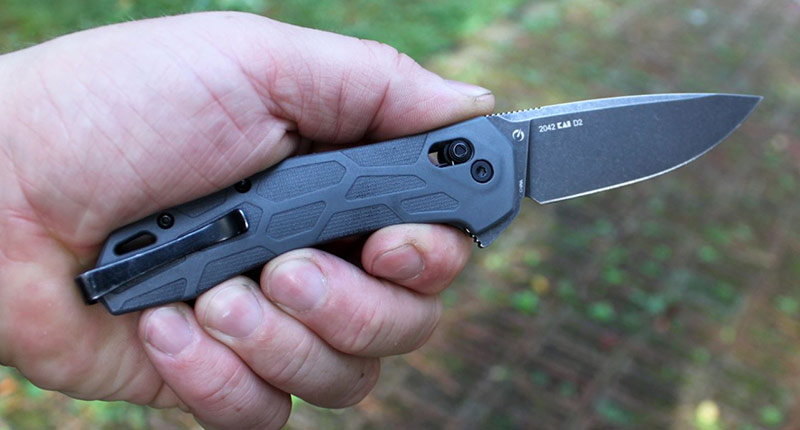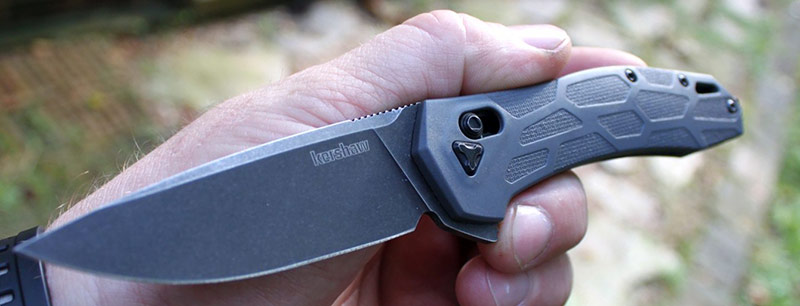We independently evaluate all recommended products and services. Any products or services put forward appear in no particular order. If you click on links we provide, we may receive compensation.

Kershaw Covalent
Quality/Performance - 74%
Value for Money - 80%
77%
- Pros: Light weight, slim, combines great flipper action with a sliding bar lock, funky fresh design, useful blade shape and geometry
- Cons: Minor quality control issues, loop-over-top clip is less than ideal, non-skeletonized liners, funky looks might not be your cup of tea
Fresh on the heels of reviewing the surprisingly excellent Kershaw Heist, equipped with Kershaw’s new Dura-Lock, we’re also taking a look at the Covalent. The Covalent is one of four knives that Kershaw released at the same time with their new sliding-bar lock, which is KAI’s equivalent of an AXIS lock or other similar locks under different names from a range of brands. While the Heist and Iridium feature thumb stud deployment, the Covalent and the Monitor both utilize flipper tabs for opening, with a mix of high quality and solid materials for quite reasonable price tags.
Key Specs: Kershaw Covalent
Having gotten accustomed to many years of budget Kershaws featuring unimpressive 8Cr13MoV steel, spring-assisted actions and overwrought looks – which are inevitably produced for two years and discontinued like a fast fashion line – knives like the Heist and the Covalent are a sign that some things changing at Kershaw. The Iridium, with its sleek looking aluminum handle scales and smooth bearing pivot action, has actually sold out and is awaiting another production run to meet demand – something I haven’t heard of happening to an entry level Kershaw knife in years. The Heist blew me away as a realistic budget alternative to the Benchmade Bugout (at a third of the price) and seems like an excellent EDC option out of the box. It remains to be seen if the flipper-equipped Dura-Lock knives are as successful, but things look promising. Let’s look a little closer at the Covalent, and see if we… bond with it. Get it? Covalent bond? Moving on.
The Blade
The Covalent’s blade shape is what I consider perfect for day-to-day use. Everyone’s opinion on this might vary, but for a regular use pocket knife, I want a full-flat grind on a standard drop point, with just a little belly for roll cuts and a nice pointy tip for piercing things. There’s a reason all the most successful EDC knives have blades that look like this – they just work. Measuring in at 3.2” long with a 3” cutting edge, the Covalent’s blade is cut from 0.10” blade stock – just barely thicker than the Heist’s 0.09” blade stock. It comes down to 0.025” measured with digital calipers behind the edge, so the Covalent should make for a good slicer. The flat grind goes almost all the way to the spine, with a shallow false swedge running along the top of the blade from about ¾” aft of the tip all the way to right before the blade tang.

Kershaw has gotten creative with the grinds on these newn Dura-Lock knives, and the intersection of the plunge grind with the swedge and its straight diagonal drop towards the sharpening choil gives the surface of the blade some depth. The sharpening choil is slightly too far back, leaving just a hair of a beard at the terminating edge of the blade. The Covalent has a run of evenly spaced jimping on the spine for grip, but no thumb ramp or forward finger choil.

Like the rest of the knives with the Dura-Lock so far, the Covalent features D2 tool steel. While use of this tool steel in knifemaking dates back to the mid 1960’s(!), some things don’t need to be changed just because they’re old. D2 has relatively high carbon and low chromium content, so it will hold an edge longer than most comparable budget steels, but is less resistant to corrosion – it’s not a full high carbon steel that requires special attention like 1095 or 3V, but it will absolutely stain if you abuse it. It will hold an edge longer than 14c28n or 8Cr steel, and is generally tougher (more resistant to chipping) than those other steels, while being slightly harder to sharpen. Kershaw has seen fit here to apply both a stonewash finish – which hides scratches – as well as a light grey black oxide coating to the blade, which makes it more rust-resistant.
Deployment & Lockup
Traditionally, sliding-bar locks and flipper knives have been two things that don’t go together. I learned this the first time I picked up an old Benchmade 300-1 Axis Lock flipper, which had what I must describe as the single worst detent of any flipper knife I’ve ever experienced. Almost fully incapable of building up enough detent strength to allow the blade to open fully without a wrist flick, the 300-1 was both unappealing to look at (seriously) and unsuccessful as a concept.

Thankfully, things have come a long way since then. The Covalent is flipper deployment only, with a short tab featuring jimping on the forward surface for traction, operated in a push-button style (with a downward and inward direction.) It actually has quite a strong closed detent, which combined with Kershaw’s KVT caged ball bearings, makes for sure-fire deployment with a satisfying “snap.” The lock itself uses dual-sided omega springs to force the bar forward over the tang in the open and closed positions, and is supported by an external stop pin that locates the blade in both positions as well.

Kershaw’s adaptation of the sliding bar lock works great, with a strong pull to the springs and no catching or grittiness to the action. It’s also intrinsically safer than a liner lock when closing, since you can pull back on the lock and swing the blade shut without your fingers ever entering the path of the blade, and thanks to the ball bearings the knife falls shut easier than the washer-equipped Heist model. The combination of strong detent and drop-shut pivot means the Covalent is a fun knife to fiddle with, if you’re prone to that sort of thing. Lockup is perfect, with no vertical or horizontal blade play observed during testing.
Features, Fit & Finish
Kershaw likes to make a funky looking knife, and the Covalent fits the bill here thanks to its decorative textured scales. They’re made from glass-filled nylon with textured pockets, a random asymmetrical pattern of angular shapes with a fine mesh texture embedded. Further interesting details are found along the spine: the appearance of the solid backspacer is broken up by the liners peeking through the top of the scales, giving the illusion of the backspacer itself being a varying width, alternating between a geared pattern on the backspacer and on the exposed liners with flat spots on the backspacer. It’s a neat effect.

Construction is bolt-through on both sides, with Torx T6 for the body and pocket clip screws, and a Torx T8 for the pivot tension adjustment. Opposite of that T8 Pivot screw is a small decorative pivot, triangle-shaped and protruding from the scales, which holds the pivot from turning when the screw is adjusted. The backspacer is solid plastic (so no flow-through construction) and everything attaches to solid, non-skeletonized stainless liners which are nested inside the scales. The pocket clip is unusual, a super-deep carry unit that slots into the butt of the handle and wraps around the opposite side, and is reversible for left- or right-hand tip-up carry. It has a Kershaw logo on the back of the clip (the portion that folds over the rear of the handle), and there’s some additional branding and info on the blade: one side also has the Kershaw logo etched in, while the opposite side features the model number, KAI symbol and Kershaw in-house design symbol, the steel type and country of origin. If you’re left-handed, good news: the Covalent is fully ambidextrous, from deployment to lock release to clip positioning.

Fit and finish on the Covalent are fine, not exemplary. There are some rough spots in the casting of the scales around the edges near the backspacer and the bottom, one of the body screws sits noticeably above the surface of the scales, along with the aforementioned “beard” at the terminating end of the sharpened edge. These are all pretty minor issues – the blade is well centered when closed, the edge grind is clean and symmetrical (as are the primary bevels) and I’m a big fan of the black oxide stonewash combo finish on the blade. It was also set up properly out of the box, requiring no adjustment of pivot tension to get it dialed in. It’s a great looking knife, well-proportioned to the eyes, and generally well made for the price point.
Field Test
The Covalent weighs in at a scant 2.84 ounces, with a 4.4” closed length and a 7.50” overall length. It’s a similar size and weight to the Heist, being only slightly wider in the handles (0.49”). The primary difference in carry is the clip, which screws onto the side of the handle in the Heist but loops over the top on the Covalent. I’ve tested several knives that have a loop-over deep carry clip and have disliked the clip on all of them. The SOG Terminus XR was the worst offender, but the pricey Spyderco LionSpy also had one of these clips that wraps over the butt of the handle, and in all of them I encountered the same problem: mainly, that the hem of your pocket rides up into the space at the top of the clip and makes the knife quite difficult to retrieve once it’s in there. Beyond the grabby pocket clip the Covalent carries nicely, its light weight and slim profile (including an unobtrusive flipper tab) making it disappear in your pocket.

In use, the Covalent shines as an all-purpose EDC knife, especially at this price. It’s solid ergonomically: the contoured handles don’t force your hand into any particular grip, and the textured pattern keeps the knife from getting slippery with oil. It doesn’t have a forward choil or a thumb ramp, but the flipper tab serves double duty as a finger guard, and the upside of the wrap-around deep carry clip is that it keeps the body of the clip out of your palm when you’re gripping the knife. The run of jimping along the spine is useful when you’re using the knife in a pivot pinch-grip.

Thanks to the high flat grind and thin tip geometry, the Covalent pierces hard plastic smoothly, and the curved belly is great for slicing and draw cuts. I have absolutely no problem with D2 on an EDC knife, as it holds an edge noticeably longer than other steels in this price range, and is easy to sharpen with basic equipment. The normal blade shape also helps, without a recurve or tanto edge to worry about. As with most sliding bar lock knives, I avoided taking the Covalent apart any more than I needed to – they’re more of a hassle than a conventional frame lock or liner lock knife to disassemble. The lack of flow-through construction (using standoffs instead of a backspacer) is a let-down here since it’s harder to clean gunk out of the knife and the complex lock mechanism is a deterrent to disassembly.
Alternatives
All these knives available at BladeHQ.
The Kershaw Covalent has an MSRP of $72, and at the time of writing has a retail price of $55 on BladeHQ. Narrowing down the field of competitors is daunting, because looking at BladeHQ for a pocket knife under $100, with a 3-3.5” blade and flipper deployment, yields a staggering 1,238 items.Narrowing it down even further – including a cross-bar lock – brings up the often-compared SOG Terminus XR folder, with G10 handles and a D2 blade, at an identical $55 retail price. Terminus XR is a half-ounce heavier at 3.32 ounces, but it includes a choice between a flipper and thumb studs for deployment. It is otherwise very similar, with the same blade steel, loop-over-top ambidextrous deep carry clip, caged ball bearing pivot, and blade shape. The Terminus is shorter – 7″ overall – and uses G10 instead of glass filled nylon handles, and its proportions are shorter and stouter than the Covalent, but they are definitely aimed at similar buyers, and both seem like great choices for your $55.

The other option that meets all those criteria is the Gerber Highbrow flipper, but a quick perusal of the specs shows it’s not a fair fight for the Gerber: it offers worse steel (7Cr17MoV), a much heavier weight (4.96 ounces), and like a lot of Gerber knives it has a confusingly chunky blade grind, the primary bevel stopping halfway up the blade. It’s also assisted opening, which I am never a fan of. The aluminum handles with a simulated bolster are cool, but it packs a lot less blade (2.8”) into almost double the weight.

WE Knife’s budget brand Sencut makes a compelling alternative called the Sachse. Slightly longer and heavier, with a 3.47” blade / 7.81” overall length and 3.6 ounce weight, the Sachse’s drop point blade is made from satin finished 9Cr18MoV, a decent budget steel. It features both a flipper tab and ambidextrous thumb studs for deployment – which is via a ball bearing pivot, of course. Lockup is provided by a button lock, which is becoming more common at this price point now. Most of them come with micarta handles, but there’s also an option of natural jade green G10 scales as well. The Sachse, like most of Sencut’s line, is a very straightforward no-nonsense design, much like the Acumen we reviewed previously. This means that while it’s well made and functional there’s not really any design flare, which WE Knife seems to save for the next brand up in the family tree, Civivi. It is hard to argue with the product, especially for the $50 retail price, it’s just not very adventurous.

Finally, an interesting alternative from Kizer is the Vanguard-line Spot flipper. It’s hard to miss thanks to black and red swirled G10 handle scales, and it features a similarly slim and pocketable profile to the Covalent. It weighs in at 2.8 ounces like the Kershaw, with a 3” clip point blade made from 154CM stainless steel – a slight step up in performance. It’s a bit shorter at 6.9” overall, but both knives have the kind of slim build that consumes minimum pocket space, and the Spot also has a deep carry tip-up pocket clip – although it’s right hand only. Both are flipper deployment only via ball bearings, but the Kizer uses a liner lock rather than a sliding bar lock, making it simpler but less fidget-friendly. For the materials, it seems like a great deal at $69 retail.
Wrap-Up
Much like the Heist, the Covalent didn’t immediately impress me when I pulled it out of the box – it’s more of a slow burn. But all the ingredients are there for a great EDC knife – it’s overall good for carry, being light and narrow in the pocket. It has a usable but not excessive blade length, in a practical shape with a nearly full flat grind for proper geometry. With a sharp tip, continuously curved edge with a little belly, thin blade stock and a decent performing steel, the Covalent’s blade is ready for basically any day-to-day task you throw at it. And while funky textures and decorative pivots and backspacer don’t necessarily make a knife perform better or last longer, they can make it more of a joy to carry and use, and if we’re being honest with ourselves that’s at least half the point of carrying a knife. On the downside, the lack of skeletonized liners is odd, and the over-the-top deep carry clip is an annoyance
Beyond theoretical design discussions, I do have to applaud the implementation of the sliding bar lock with flipper deployment on the Covalent, especially considering this series of knives is Kershaw’s first foray into this lock – it has a great detent and is a solid flipper, fun to fidget with. Also, a few small nitpicks aside, it’s a well-made product for the retail price. For a budget EDC, you just might make a solid bond with the Covalent.





